Clinical Reflection Blogs
VerifiedAdded on 2020/03/16
|9
|1289
|38
Journal and Reflective Writing
AI Summary
The content consists of clinical reflection blogs written by nursing students, detailing their experiences and learning outcomes during various clinical placements. Each blog entry outlines specific objectives, actions taken, and the outcomes of their experiences, emphasizing the importance of effective communication, adherence to professional standards, and the application of nursing skills in real-world scenarios. The reflections cover a range of topics including patient check-ups, blood transfusions, catheterization, and interactions with patients in mental health settings.
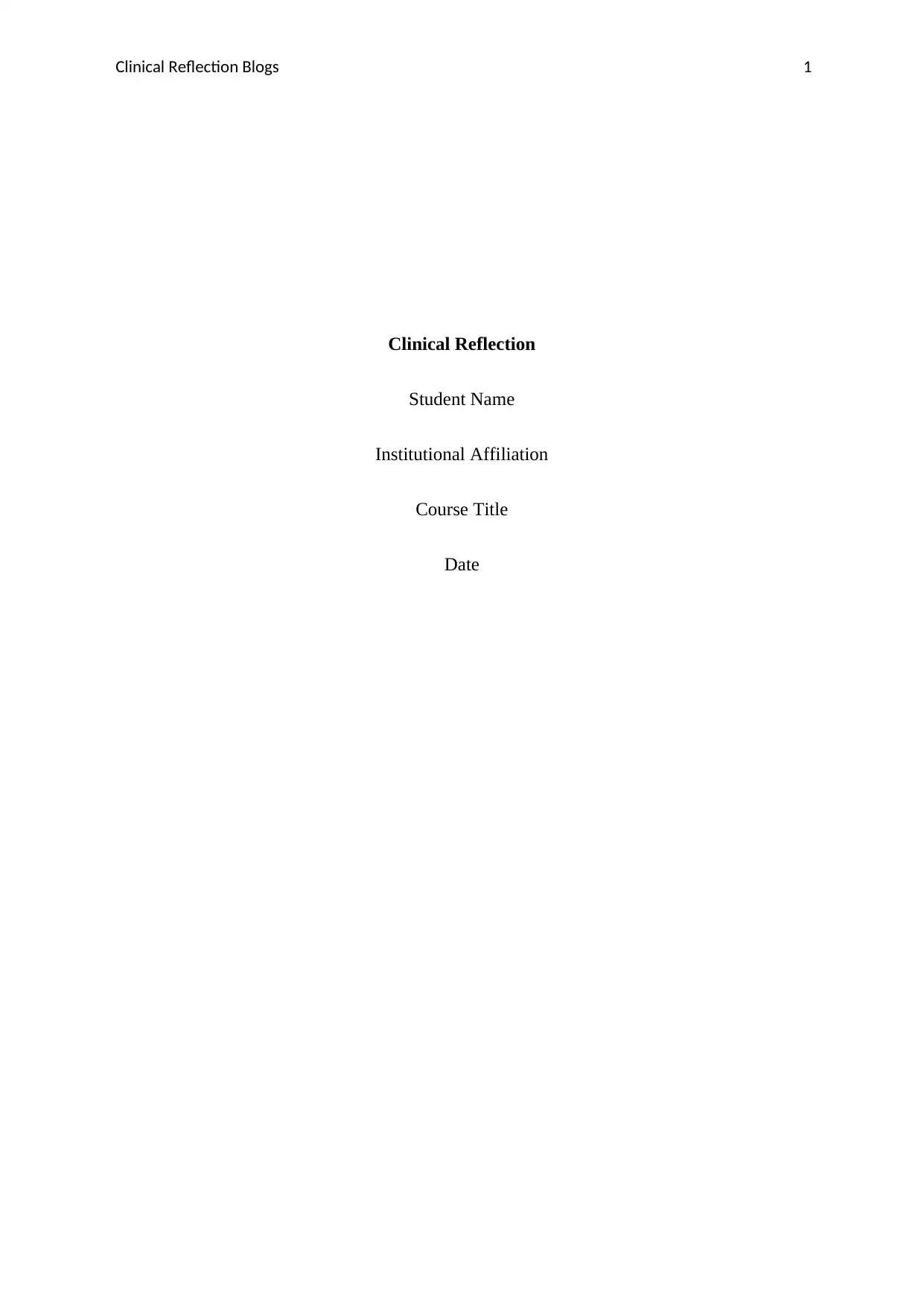
Clinical Reflection Blogs 1
Clinical Reflection
Student Name
Institutional Affiliation
Course Title
Date
Clinical Reflection
Student Name
Institutional Affiliation
Course Title
Date
Paraphrase This Document
Need a fresh take? Get an instant paraphrase of this document with our AI Paraphraser
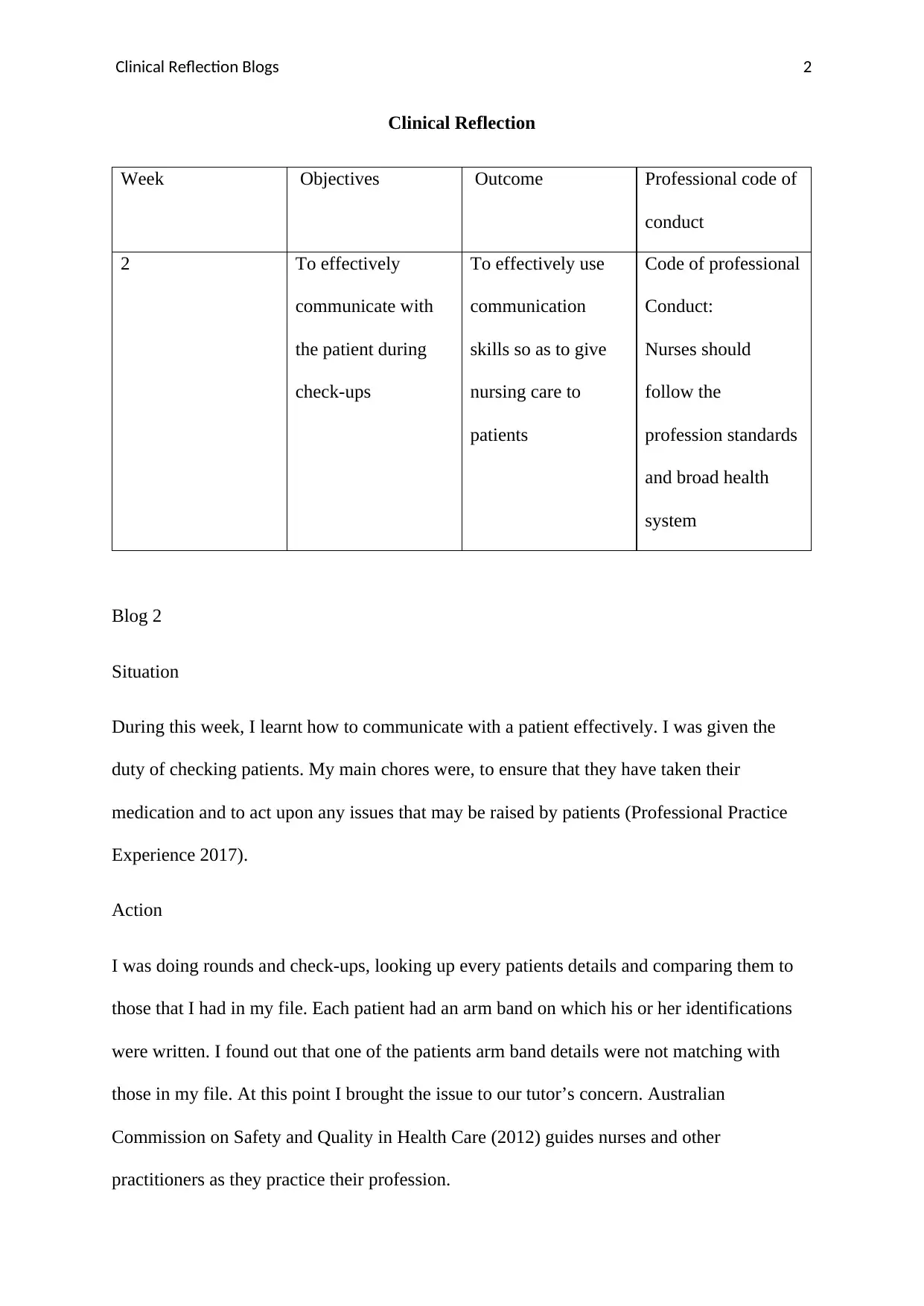
Clinical Reflection Blogs 2
Clinical Reflection
Week Objectives Outcome Professional code of
conduct
2 To effectively
communicate with
the patient during
check-ups
To effectively use
communication
skills so as to give
nursing care to
patients
Code of professional
Conduct:
Nurses should
follow the
profession standards
and broad health
system
Blog 2
Situation
During this week, I learnt how to communicate with a patient effectively. I was given the
duty of checking patients. My main chores were, to ensure that they have taken their
medication and to act upon any issues that may be raised by patients (Professional Practice
Experience 2017).
Action
I was doing rounds and check-ups, looking up every patients details and comparing them to
those that I had in my file. Each patient had an arm band on which his or her identifications
were written. I found out that one of the patients arm band details were not matching with
those in my file. At this point I brought the issue to our tutor’s concern. Australian
Commission on Safety and Quality in Health Care (2012) guides nurses and other
practitioners as they practice their profession.
Clinical Reflection
Week Objectives Outcome Professional code of
conduct
2 To effectively
communicate with
the patient during
check-ups
To effectively use
communication
skills so as to give
nursing care to
patients
Code of professional
Conduct:
Nurses should
follow the
profession standards
and broad health
system
Blog 2
Situation
During this week, I learnt how to communicate with a patient effectively. I was given the
duty of checking patients. My main chores were, to ensure that they have taken their
medication and to act upon any issues that may be raised by patients (Professional Practice
Experience 2017).
Action
I was doing rounds and check-ups, looking up every patients details and comparing them to
those that I had in my file. Each patient had an arm band on which his or her identifications
were written. I found out that one of the patients arm band details were not matching with
those in my file. At this point I brought the issue to our tutor’s concern. Australian
Commission on Safety and Quality in Health Care (2012) guides nurses and other
practitioners as they practice their profession.
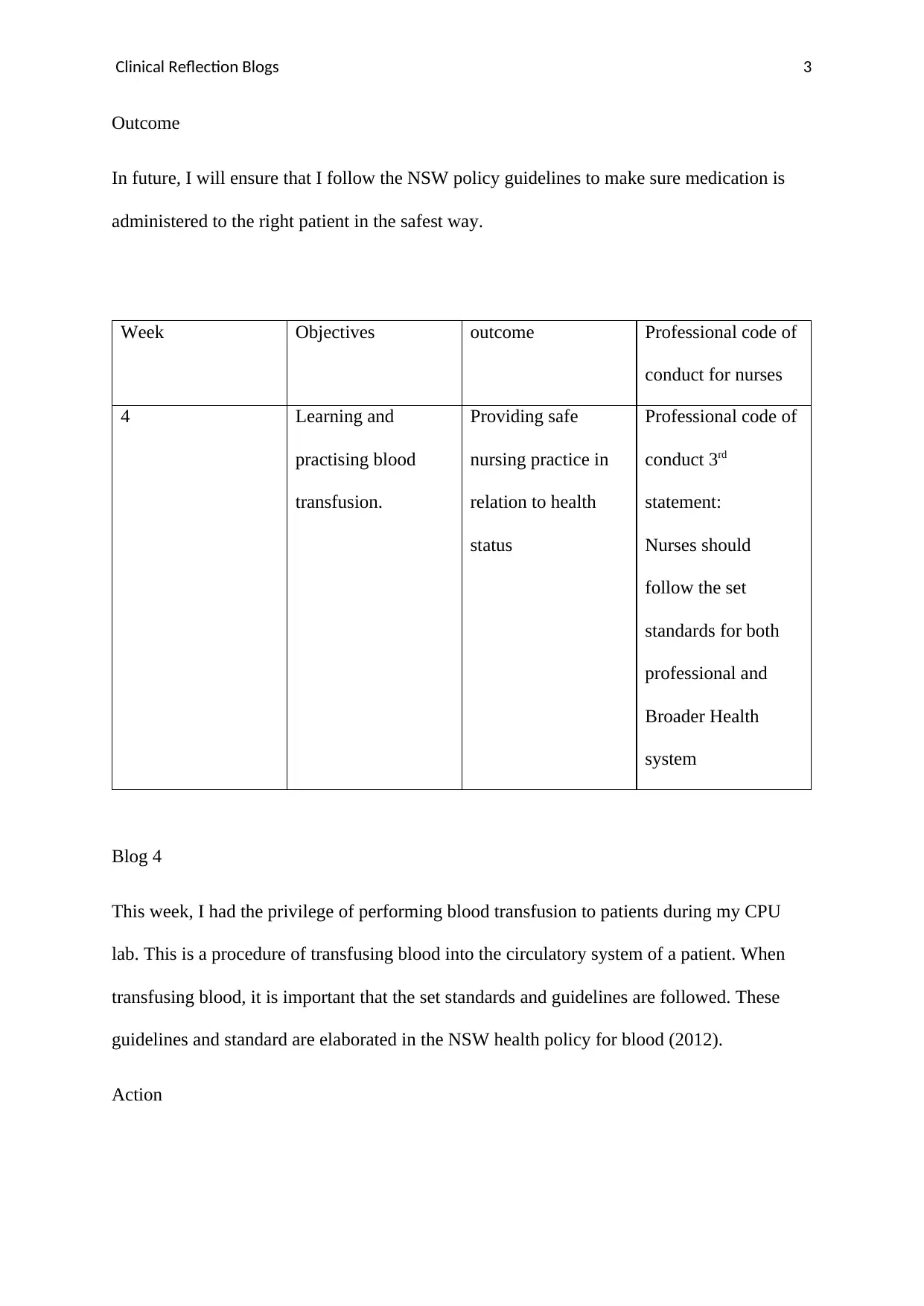
Clinical Reflection Blogs 3
Outcome
In future, I will ensure that I follow the NSW policy guidelines to make sure medication is
administered to the right patient in the safest way.
Week Objectives outcome Professional code of
conduct for nurses
4 Learning and
practising blood
transfusion.
Providing safe
nursing practice in
relation to health
status
Professional code of
conduct 3rd
statement:
Nurses should
follow the set
standards for both
professional and
Broader Health
system
Blog 4
This week, I had the privilege of performing blood transfusion to patients during my CPU
lab. This is a procedure of transfusing blood into the circulatory system of a patient. When
transfusing blood, it is important that the set standards and guidelines are followed. These
guidelines and standard are elaborated in the NSW health policy for blood (2012).
Action
Outcome
In future, I will ensure that I follow the NSW policy guidelines to make sure medication is
administered to the right patient in the safest way.
Week Objectives outcome Professional code of
conduct for nurses
4 Learning and
practising blood
transfusion.
Providing safe
nursing practice in
relation to health
status
Professional code of
conduct 3rd
statement:
Nurses should
follow the set
standards for both
professional and
Broader Health
system
Blog 4
This week, I had the privilege of performing blood transfusion to patients during my CPU
lab. This is a procedure of transfusing blood into the circulatory system of a patient. When
transfusing blood, it is important that the set standards and guidelines are followed. These
guidelines and standard are elaborated in the NSW health policy for blood (2012).
Action
⊘ This is a preview!⊘
Do you want full access?
Subscribe today to unlock all pages.

Trusted by 1+ million students worldwide
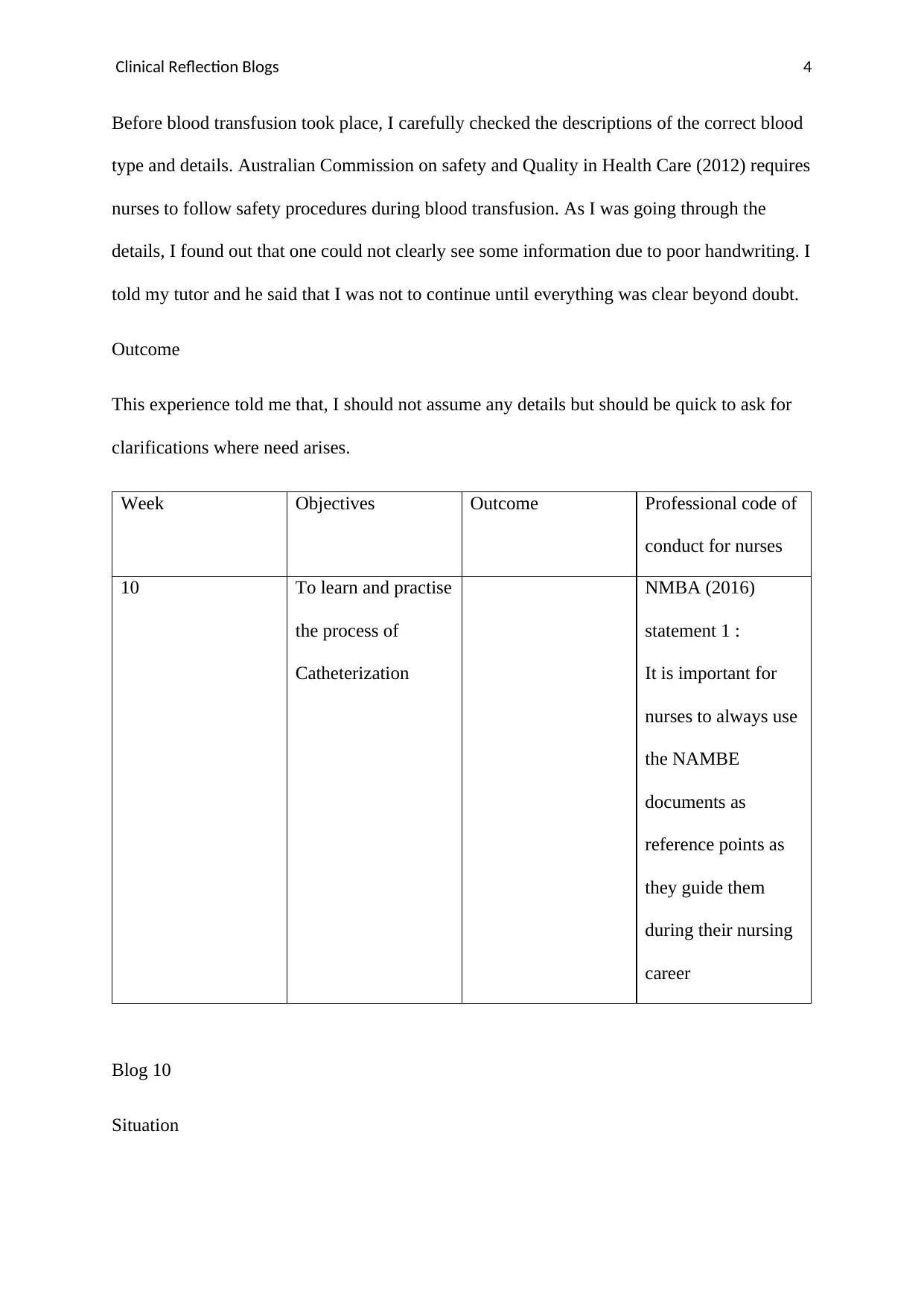
Clinical Reflection Blogs 4
Before blood transfusion took place, I carefully checked the descriptions of the correct blood
type and details. Australian Commission on safety and Quality in Health Care (2012) requires
nurses to follow safety procedures during blood transfusion. As I was going through the
details, I found out that one could not clearly see some information due to poor handwriting. I
told my tutor and he said that I was not to continue until everything was clear beyond doubt.
Outcome
This experience told me that, I should not assume any details but should be quick to ask for
clarifications where need arises.
Week Objectives Outcome Professional code of
conduct for nurses
10 To learn and practise
the process of
Catheterization
NMBA (2016)
statement 1 :
It is important for
nurses to always use
the NAMBE
documents as
reference points as
they guide them
during their nursing
career
Blog 10
Situation
Before blood transfusion took place, I carefully checked the descriptions of the correct blood
type and details. Australian Commission on safety and Quality in Health Care (2012) requires
nurses to follow safety procedures during blood transfusion. As I was going through the
details, I found out that one could not clearly see some information due to poor handwriting. I
told my tutor and he said that I was not to continue until everything was clear beyond doubt.
Outcome
This experience told me that, I should not assume any details but should be quick to ask for
clarifications where need arises.
Week Objectives Outcome Professional code of
conduct for nurses
10 To learn and practise
the process of
Catheterization
NMBA (2016)
statement 1 :
It is important for
nurses to always use
the NAMBE
documents as
reference points as
they guide them
during their nursing
career
Blog 10
Situation
Paraphrase This Document
Need a fresh take? Get an instant paraphrase of this document with our AI Paraphraser
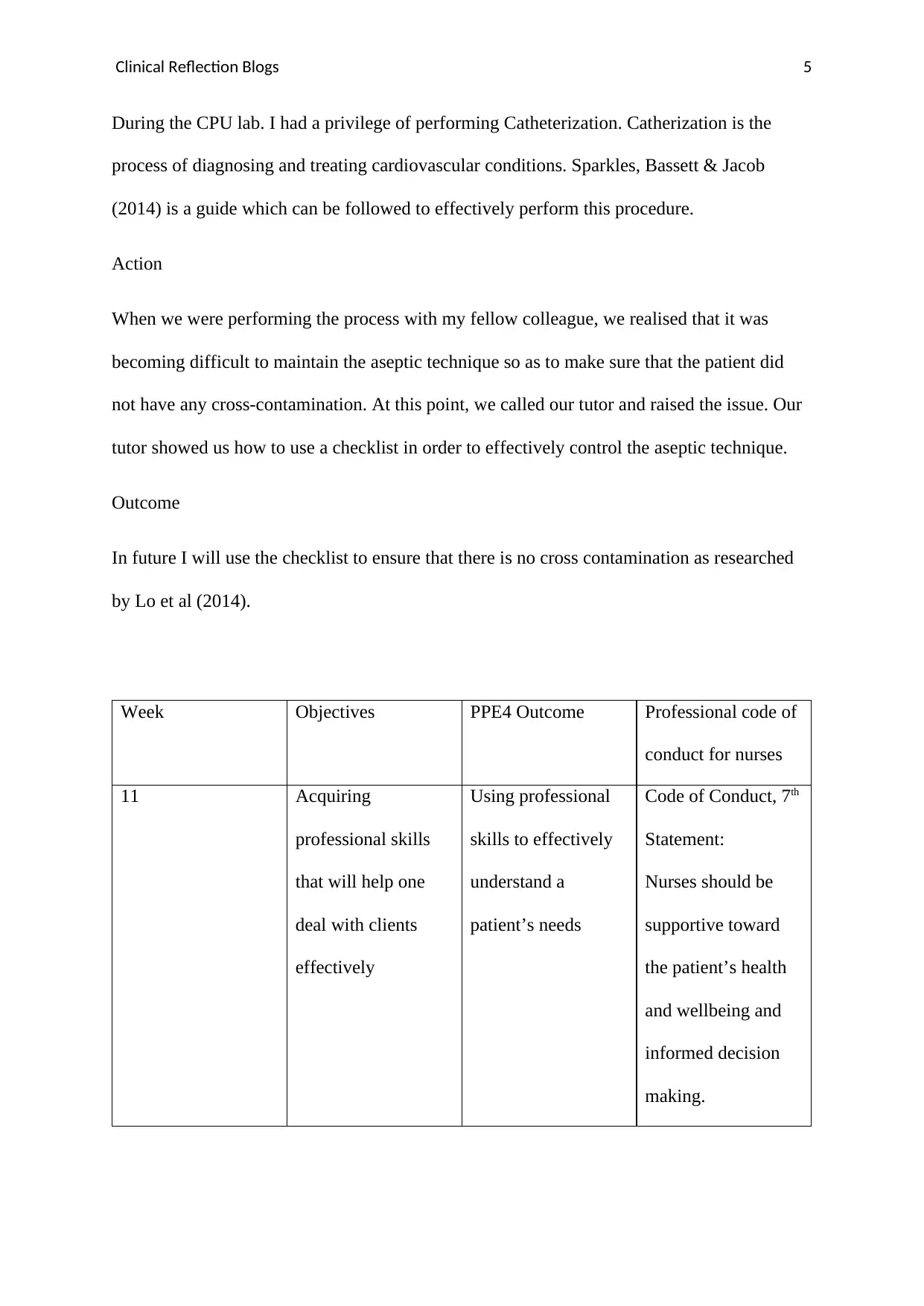
Clinical Reflection Blogs 5
During the CPU lab. I had a privilege of performing Catheterization. Catherization is the
process of diagnosing and treating cardiovascular conditions. Sparkles, Bassett & Jacob
(2014) is a guide which can be followed to effectively perform this procedure.
Action
When we were performing the process with my fellow colleague, we realised that it was
becoming difficult to maintain the aseptic technique so as to make sure that the patient did
not have any cross-contamination. At this point, we called our tutor and raised the issue. Our
tutor showed us how to use a checklist in order to effectively control the aseptic technique.
Outcome
In future I will use the checklist to ensure that there is no cross contamination as researched
by Lo et al (2014).
Week Objectives PPE4 Outcome Professional code of
conduct for nurses
11 Acquiring
professional skills
that will help one
deal with clients
effectively
Using professional
skills to effectively
understand a
patient’s needs
Code of Conduct, 7th
Statement:
Nurses should be
supportive toward
the patient’s health
and wellbeing and
informed decision
making.
During the CPU lab. I had a privilege of performing Catheterization. Catherization is the
process of diagnosing and treating cardiovascular conditions. Sparkles, Bassett & Jacob
(2014) is a guide which can be followed to effectively perform this procedure.
Action
When we were performing the process with my fellow colleague, we realised that it was
becoming difficult to maintain the aseptic technique so as to make sure that the patient did
not have any cross-contamination. At this point, we called our tutor and raised the issue. Our
tutor showed us how to use a checklist in order to effectively control the aseptic technique.
Outcome
In future I will use the checklist to ensure that there is no cross contamination as researched
by Lo et al (2014).
Week Objectives PPE4 Outcome Professional code of
conduct for nurses
11 Acquiring
professional skills
that will help one
deal with clients
effectively
Using professional
skills to effectively
understand a
patient’s needs
Code of Conduct, 7th
Statement:
Nurses should be
supportive toward
the patient’s health
and wellbeing and
informed decision
making.
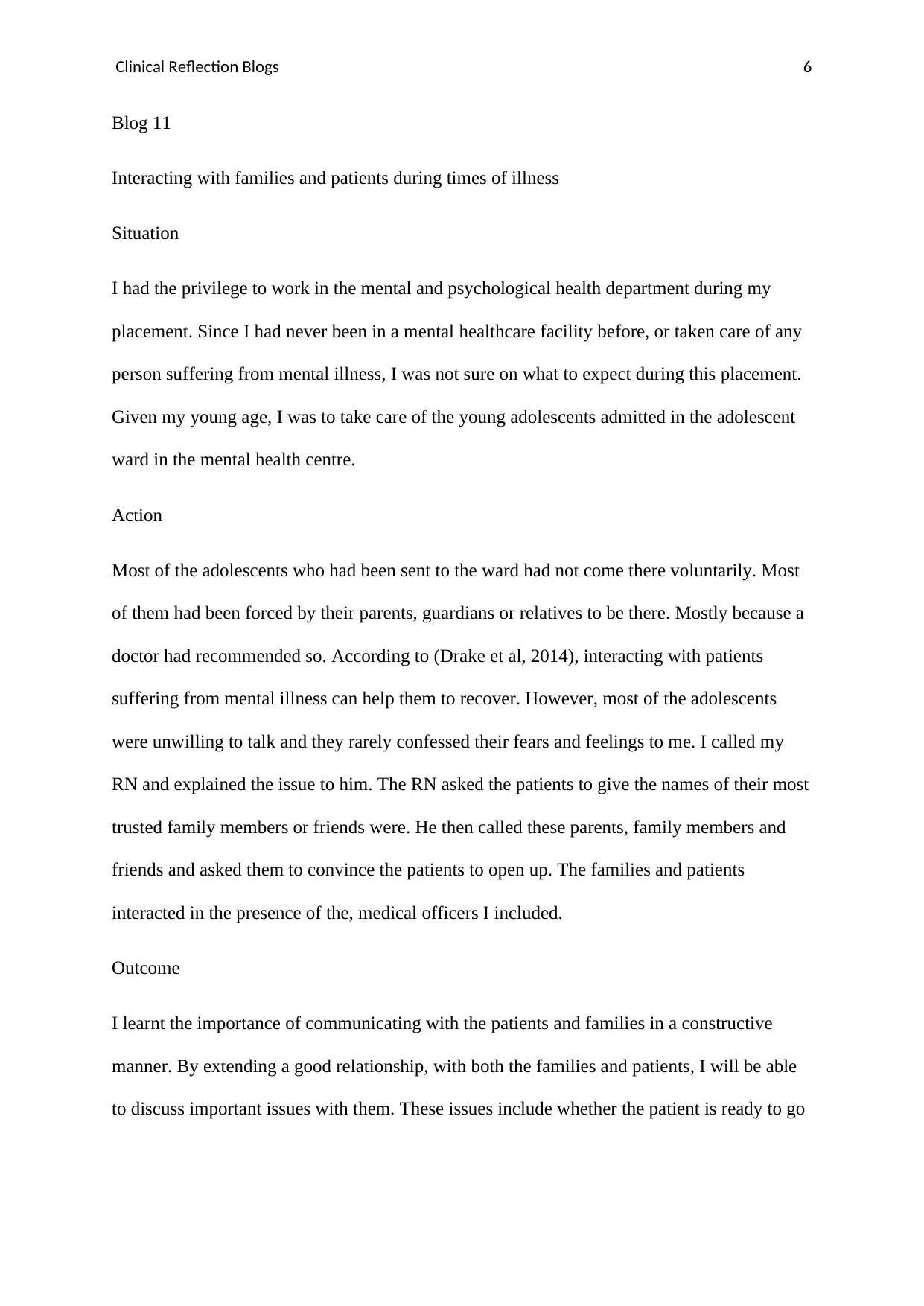
Clinical Reflection Blogs 6
Blog 11
Interacting with families and patients during times of illness
Situation
I had the privilege to work in the mental and psychological health department during my
placement. Since I had never been in a mental healthcare facility before, or taken care of any
person suffering from mental illness, I was not sure on what to expect during this placement.
Given my young age, I was to take care of the young adolescents admitted in the adolescent
ward in the mental health centre.
Action
Most of the adolescents who had been sent to the ward had not come there voluntarily. Most
of them had been forced by their parents, guardians or relatives to be there. Mostly because a
doctor had recommended so. According to (Drake et al, 2014), interacting with patients
suffering from mental illness can help them to recover. However, most of the adolescents
were unwilling to talk and they rarely confessed their fears and feelings to me. I called my
RN and explained the issue to him. The RN asked the patients to give the names of their most
trusted family members or friends were. He then called these parents, family members and
friends and asked them to convince the patients to open up. The families and patients
interacted in the presence of the, medical officers I included.
Outcome
I learnt the importance of communicating with the patients and families in a constructive
manner. By extending a good relationship, with both the families and patients, I will be able
to discuss important issues with them. These issues include whether the patient is ready to go
Blog 11
Interacting with families and patients during times of illness
Situation
I had the privilege to work in the mental and psychological health department during my
placement. Since I had never been in a mental healthcare facility before, or taken care of any
person suffering from mental illness, I was not sure on what to expect during this placement.
Given my young age, I was to take care of the young adolescents admitted in the adolescent
ward in the mental health centre.
Action
Most of the adolescents who had been sent to the ward had not come there voluntarily. Most
of them had been forced by their parents, guardians or relatives to be there. Mostly because a
doctor had recommended so. According to (Drake et al, 2014), interacting with patients
suffering from mental illness can help them to recover. However, most of the adolescents
were unwilling to talk and they rarely confessed their fears and feelings to me. I called my
RN and explained the issue to him. The RN asked the patients to give the names of their most
trusted family members or friends were. He then called these parents, family members and
friends and asked them to convince the patients to open up. The families and patients
interacted in the presence of the, medical officers I included.
Outcome
I learnt the importance of communicating with the patients and families in a constructive
manner. By extending a good relationship, with both the families and patients, I will be able
to discuss important issues with them. These issues include whether the patient is ready to go
⊘ This is a preview!⊘
Do you want full access?
Subscribe today to unlock all pages.

Trusted by 1+ million students worldwide
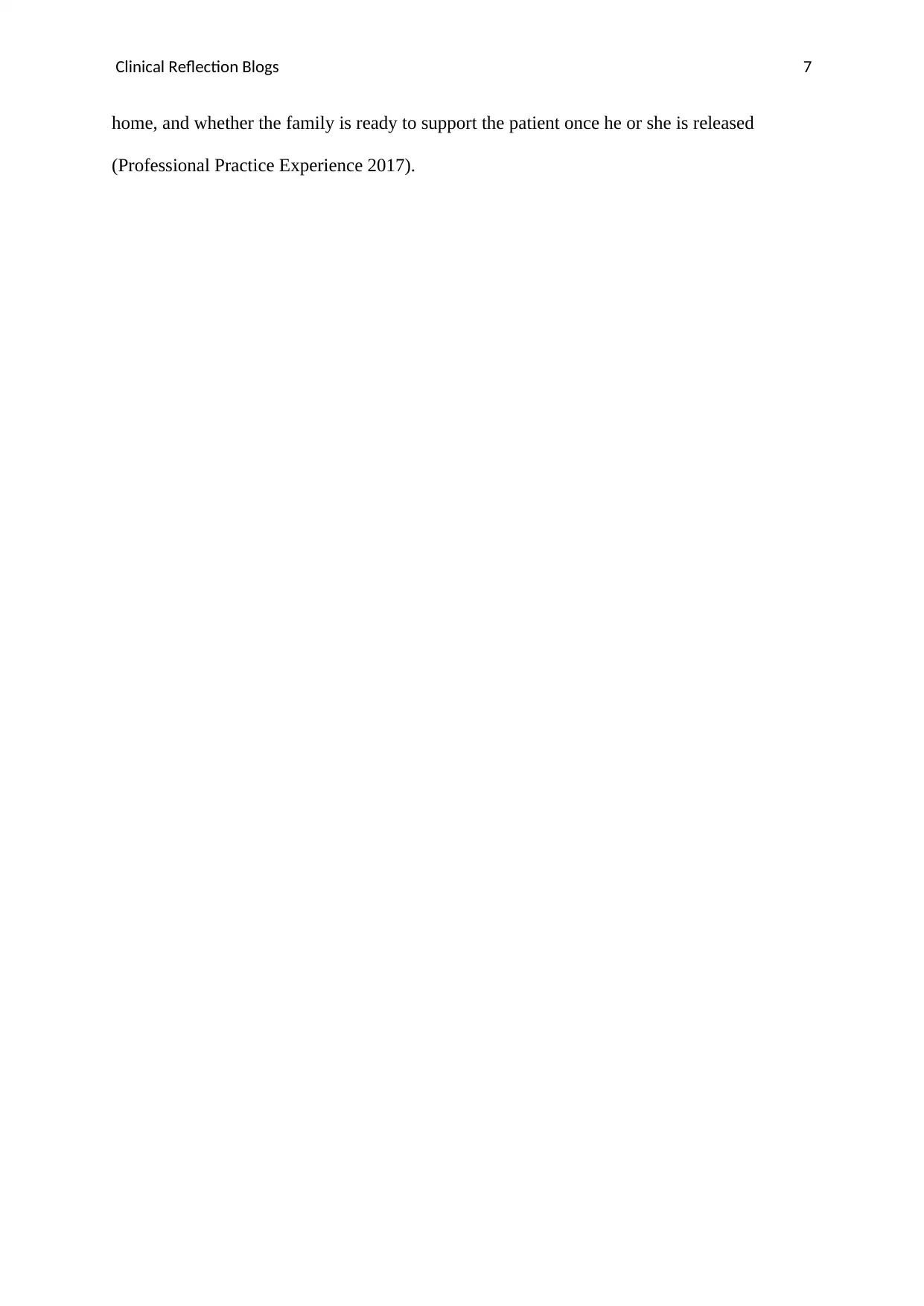
Clinical Reflection Blogs 7
home, and whether the family is ready to support the patient once he or she is released
(Professional Practice Experience 2017).
home, and whether the family is ready to support the patient once he or she is released
(Professional Practice Experience 2017).
Paraphrase This Document
Need a fresh take? Get an instant paraphrase of this document with our AI Paraphraser
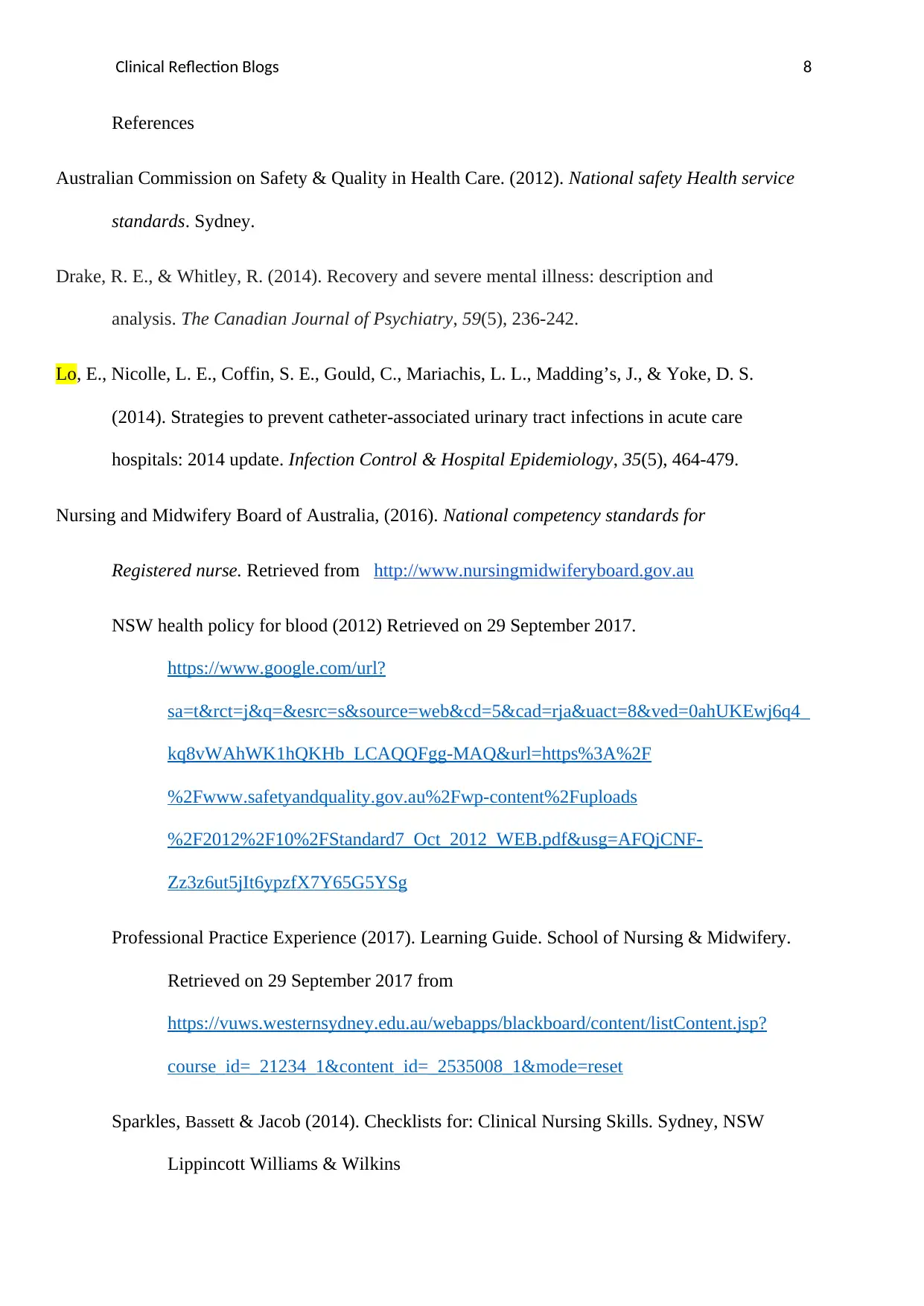
Clinical Reflection Blogs 8
References
Australian Commission on Safety & Quality in Health Care. (2012). National safety Health service
standards. Sydney.
Drake, R. E., & Whitley, R. (2014). Recovery and severe mental illness: description and
analysis. The Canadian Journal of Psychiatry, 59(5), 236-242.
Lo, E., Nicolle, L. E., Coffin, S. E., Gould, C., Mariachis, L. L., Madding’s, J., & Yoke, D. S.
(2014). Strategies to prevent catheter-associated urinary tract infections in acute care
hospitals: 2014 update. Infection Control & Hospital Epidemiology, 35(5), 464-479.
Nursing and Midwifery Board of Australia, (2016). National competency standards for
Registered nurse. Retrieved from http://www.nursingmidwiferyboard.gov.au
NSW health policy for blood (2012) Retrieved on 29 September 2017.
https://www.google.com/url?
sa=t&rct=j&q=&esrc=s&source=web&cd=5&cad=rja&uact=8&ved=0ahUKEwj6q4_
kq8vWAhWK1hQKHb_LCAQQFgg-MAQ&url=https%3A%2F
%2Fwww.safetyandquality.gov.au%2Fwp-content%2Fuploads
%2F2012%2F10%2FStandard7_Oct_2012_WEB.pdf&usg=AFQjCNF-
Zz3z6ut5jIt6ypzfX7Y65G5YSg
Professional Practice Experience (2017). Learning Guide. School of Nursing & Midwifery.
Retrieved on 29 September 2017 from
https://vuws.westernsydney.edu.au/webapps/blackboard/content/listContent.jsp?
course_id=_21234_1&content_id=_2535008_1&mode=reset
Sparkles, Bassett & Jacob (2014). Checklists for: Clinical Nursing Skills. Sydney, NSW
Lippincott Williams & Wilkins
References
Australian Commission on Safety & Quality in Health Care. (2012). National safety Health service
standards. Sydney.
Drake, R. E., & Whitley, R. (2014). Recovery and severe mental illness: description and
analysis. The Canadian Journal of Psychiatry, 59(5), 236-242.
Lo, E., Nicolle, L. E., Coffin, S. E., Gould, C., Mariachis, L. L., Madding’s, J., & Yoke, D. S.
(2014). Strategies to prevent catheter-associated urinary tract infections in acute care
hospitals: 2014 update. Infection Control & Hospital Epidemiology, 35(5), 464-479.
Nursing and Midwifery Board of Australia, (2016). National competency standards for
Registered nurse. Retrieved from http://www.nursingmidwiferyboard.gov.au
NSW health policy for blood (2012) Retrieved on 29 September 2017.
https://www.google.com/url?
sa=t&rct=j&q=&esrc=s&source=web&cd=5&cad=rja&uact=8&ved=0ahUKEwj6q4_
kq8vWAhWK1hQKHb_LCAQQFgg-MAQ&url=https%3A%2F
%2Fwww.safetyandquality.gov.au%2Fwp-content%2Fuploads
%2F2012%2F10%2FStandard7_Oct_2012_WEB.pdf&usg=AFQjCNF-
Zz3z6ut5jIt6ypzfX7Y65G5YSg
Professional Practice Experience (2017). Learning Guide. School of Nursing & Midwifery.
Retrieved on 29 September 2017 from
https://vuws.westernsydney.edu.au/webapps/blackboard/content/listContent.jsp?
course_id=_21234_1&content_id=_2535008_1&mode=reset
Sparkles, Bassett & Jacob (2014). Checklists for: Clinical Nursing Skills. Sydney, NSW
Lippincott Williams & Wilkins

Clinical Reflection Blogs 9
⊘ This is a preview!⊘
Do you want full access?
Subscribe today to unlock all pages.

Trusted by 1+ million students worldwide
1 out of 9
Related Documents
Your All-in-One AI-Powered Toolkit for Academic Success.
+13062052269
info@desklib.com
Available 24*7 on WhatsApp / Email
![[object Object]](/_next/static/media/star-bottom.7253800d.svg)
Unlock your academic potential
Copyright © 2020–2025 A2Z Services. All Rights Reserved. Developed and managed by ZUCOL.





